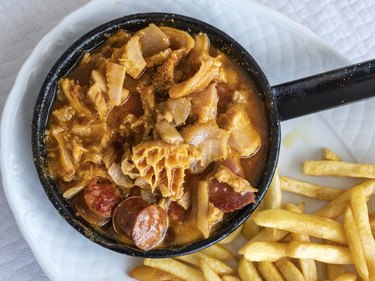
When you're watching your weight, it can be helpful to know how your meals rate in terms of nutrition and calories. If you're wondering whether tripe or tripe stew (menudo) is healthy or not, here's what you need to know.
Read more: Is Steak Good for Losing Weight?
Video of the Day
Video of the Day
Tip
Tripe is a low-calorie, low-fat, low-carb, high-protein form of meat that shouldn't derail your weight-loss goals if consumed in moderation as part of a healthy diet.
What Exactly Is Tripe?
According to the USDA, tripe is the stomach lining of beef, sheep or hogs; however, beef tripe is the most common. Tripe is categorized as a variety meat, since it's an organ meat and not taken from a standard muscle.
Michigan State University (MSU) explains that tripe is obtained from the first three of a cow's four stomachs. Tripe from the cow's first stomach (rumen) is referred to as plain, flat, smooth or blanket tripe. Meat from the second stomach (reticulum) is known as honeycomb tripe because it has such a pattern on one side. Tripe from the third stomach (omasum) is known as leaf, book or Bible tripe.
MSU says that honeycomb tripe is considered to be the best because it is meatier and more tender than the other forms of tripe; however, they are all interchangeable in recipes. Tripe meat is pretty tough, so it is usually bleached and then partially cooked before it is sold. Otherwise, it would have to be cooked for several hours before becoming tender enough to chew.
Read more: The Effects of Eating Liver
Nutrition and Calories in Tripe
Tripe is a lean, low-calorie type of meat. According to the USDA, a 4-ounce serving of tripe has only 96 calories. To help you put that in perspective, the same amount of short ribs has 271 calories, per the USDA. That's essentially triple the amount of calories.
The difference in calories is primarily due to the amount of fat in each of these types of meat. The Mayo Clinic explains that the tastiest cuts of beef are usually those with the most fat and cholesterol. The USDA says a 4-ounce serving of tripe has only 4.17 grams of fat, whereas 4 ounces of short ribs has 21.5 grams of fat. That's more than four times the fat content.
Both tripe and short ribs are low in carbs and high in protein, although the USDA notes that their protein content varies slightly. While tripe has 13.6 grams of protein per 4-ounce serving, a serving of short ribs has 19.5 grams of protein.
Overall, it's safe to say that tripe is a healthy addition to your diet and will not jeopardize your weight-loss goals if eaten in moderation. Unlike some cuts of meat, tripe is low in fat and calories. It's also low in carbs and high in protein. Furthermore, according to the USDA, it contains other nutrients like potassium, magnesium, phosphorus, calcium, selenium and B vitamins.
Menudo can also be a healthy addition to your diet, since menudo recipes usually involve simmering the tripe in a stew with herbs and spices, no oil or butter required.
Read more: 5 Healthy Red Meat Recipes That Satisfy
Red meat typically gets a bad rap, but it can be part of a healthy diet if you opt for lean, low-fat cuts, like tripe. A small study published in the January 2012 issue of the American Journal of Clinical Nutrition found that lean beef paired with a heart-healthy diet helped improve cholesterol levels and other markers of heart disease.
You should, however, avoid tripe if you have gout. The University of California, San Diego, explains that organ meats like tripe contain chemical compounds called purines that can raise the uric acid levels in your body, leading to a painful form of arthritis known as gout. A September 2012 study published in the Annals of the Rheumatic Diseases found that consuming purine-rich foods increased the frequency of gout attacks among gout patients by nearly fivefold.
- USDA: “What Is Tripe?”
- Michigan State University Extension: “Are You Throwing Away Valuable Food? Part Three: Meat”
- Michigan State University: “The Kingdom of This World”
- USDA: “Beef, Variety Meats and Byproducts, Tripe, Raw”
- USDA: “Beef, Chuck, Short Ribs, Boneless, Separable Lean and Fat, Trimmed to 0" Fat, Choice, Raw”
- Mayo Clinic: “Cuts of Beef: A Guide to the Leanest Selections”
- Texas A&M University: “Menudo”
- American Journal of Clinical Nutrition: “Beef in an Optimal Lean Diet Study: Effects on Lipids, Lipoproteins and Apolipoproteins”
- University of California, San Diego: “Eating to Prevent Gout”
- Annals of the Rheumatic Diseases: “Purine-Rich Foods Intake and Recurrent Gout Attacks”